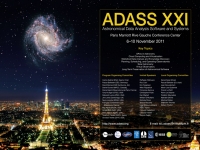Daniel Pomarede (CEA/Saclay - Irfu), Edgar Mauricio Fajardo Hernandez (CEA/Saclay - Irfu),
Daniel Pomarede (CEA/Saclay - Irfu)
Abstract
The planetary system of Saturn, its rings and its moons is a fantastic playground where physicists are confronting theories and observations. Since its insertion into orbit in 2004, the Cassini-Huygens spacecraft has returned a wealth of high-resolution
images and data that calls for the development of dedicated interactive, immersive, three-dimensional, multi-purpose analysis and visualization tools. Alongside with observations, numerical simulations also provide new insights into the fundamental processes at stake in the formation of this system. The SDvision graphical interface, developped in the context of IDL Object Graphics and intended primarily for the visualization of complex and massive astrophysical plasma simulations, has been extended to provide an interactive visualization of both numerical simulations and observations of Saturn, its rings, and its moons. One major missing feature of IDL Object Graphics is the ability to render shadow effects at all. We have overcome this limitation by developing a custom GLSL Shader that is invoked by IDL objects. This Shader, based on purely geometrical computations, is fast and allows for seamless exploratory visualization of the planetary system. This algorithm takes into account the following effects : the shadow cast by the rings on Saturn, taking into account the radial-dependent ring transparency, the shadow cast by Saturn on itself,
including the possibilities to smooth the terminator to mimick atmospheric absorption, and an optional faint illumination of the dark face to account for backlighting by the rings in their illuminated sections, and finally, the shadow cast by Saturn on the rings, with the possibility to retain a faint lighting of the rings to mimick lighting by their illuminated segments. These computations also apply to any combination related to the displayed moons, such as the shadow cast by a moon on the rings, on Saturn, and on any other moons. The implementation of this shader allows to improve the realism achieved in the rendering of both observational and simulation data. It thus contributes in the production of appealing snapshots or movies targeted at public communication, including media for stereoscopic display systems, with the intend to illustrate what are the benefits of numerical
simulations to further our understanding of planetary rings dynamics. The various functionalities offered by this tool in terms of exploration and navigation through these complex data are illustrated and discussed. Poster in PDF format
Paper ID: P120
Poster Instructions
|

